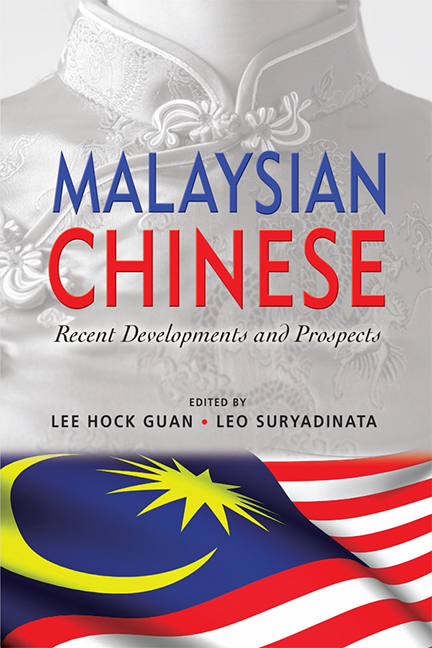Book contents
- Frontmatter
- Contents
- Preface
- Contributors
- Glossary
- Introduction
- 1 Malaysia: Ethnicity, Nationalism, and Nation Building
- 2 Being Muslim and Chinese in Malaysia
- 3 Quo Vadis: The Chinese in Malaysia
- 4 At a Crossroads: Malaysia's Coalition Politics and Chinese-based Political Parties
- 5 The End of Chinese Malaysians’ Political Division? The March 8 Political Tsunami and Chinese Politics in Penang, Selangor, and Perak
- 6 Forced to the Periphery: Recent Chinese Politics in East Malaysia
- 7 The New Malaysian Economic Agenda: Some Preliminary Observations
- 8 The Old And New Malaysian Chinese Language Press, with Special Reference to the 12th General Election
- 9 Education of the Chinese in Malaysia
- Index
Introduction
Published online by Cambridge University Press: 21 October 2015
- Frontmatter
- Contents
- Preface
- Contributors
- Glossary
- Introduction
- 1 Malaysia: Ethnicity, Nationalism, and Nation Building
- 2 Being Muslim and Chinese in Malaysia
- 3 Quo Vadis: The Chinese in Malaysia
- 4 At a Crossroads: Malaysia's Coalition Politics and Chinese-based Political Parties
- 5 The End of Chinese Malaysians’ Political Division? The March 8 Political Tsunami and Chinese Politics in Penang, Selangor, and Perak
- 6 Forced to the Periphery: Recent Chinese Politics in East Malaysia
- 7 The New Malaysian Economic Agenda: Some Preliminary Observations
- 8 The Old And New Malaysian Chinese Language Press, with Special Reference to the 12th General Election
- 9 Education of the Chinese in Malaysia
- Index
Summary
The results of the 8 March 2008 election stunned both the ruling coalition and opposition parties (Ooi et al. 2008). The Barisan Nasional were denied a two-third majority in parliament, and five states — Penang, Kedah, Perak, Selangor and Kelantan — were won by the opposition parties. Overwhelmed by the unexpected outcome, some observers characterized the election results as a “political tsunami” and extrapolated that the political landscape of Malaysia has completely changed. Of course, with the benefit of hindsight observers have become more cautious in their assessments of the impact of the March 2008 election. Nevertheless, the momentous March 2008 event is worth further examining, especially its impact on the Malaysian Chinese.
This collection of ten papers, including this introduction, attempts to assess the state of the art in the study of the Chinese community in Malaysia. It examines the nature of Malaysian multi-ethnic society and the position of the ethnic Chinese, the conflation between ethnicity and religion, the 8 March 2008 election and its impact on the community, the similarities and dissimilarities of the Chinese positions in East and West Malaysia, the new developments in the economy, and the media and education in the past few decades under the New Economic Policy that have had major bearings on the 8 March 2008 election, and the post-election Malaysian Chinese community.
NATION BUILDING AND THE POLITICS OF ETHNICITY AND IDENTITY
Since Independence in 1957, nation building in Malaysia has been bedevilled by the question of how to construct a common nationality that will have Malay culture as its core and is also inclusive of, and fair to, the non-Malay cultures. Most Chinese naturally prefer an inclusive national identity that embodies the multicultural foundation of Malaysian society. In contrast, most Malays insisted that their language, religion, and culture should be granted a privileged position in the common national identity. Indeed there are Malay leaders who would conflate Malaysian nationalism with Malay nationalism and favour using the term Melayu nationality. In the 1960s, because ethnicbounded identity was omnipotent, the prevailing sentiment was that “the Malay is first of all a Malay, then Muslim and then a Malayan; and the Chinese first of all a Chinese then a Buddhist or Christian if he is religious and then possibly a Malayan … ” (Wang 1992, p. 192).
- Type
- Chapter
- Information
- Malaysian ChineseRecent Developments and Prospects, pp. xv - xxxivPublisher: ISEAS–Yusof Ishak InstitutePrint publication year: 2011

